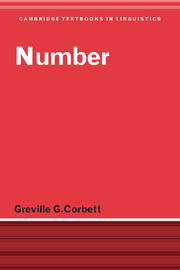Book contents
- Frontmatter
- Contents
- List of figures
- List of tables
- Preface
- List of abbreviations
- 1 Introduction
- 2 Meaning distinctions
- 3 Items involved in the nominal number system
- 4 Integrating number values and the Animacy Hierarchy
- 5 The expression of number
- 6 The syntax of number
- 7 Other uses of number
- 8 Verbal number
- 9 Conclusion and new challenges
- References
- Author index
- Language index
- Subject index
4 - Integrating number values and the Animacy Hierarchy
Published online by Cambridge University Press: 05 June 2012
- Frontmatter
- Contents
- List of figures
- List of tables
- Preface
- List of abbreviations
- 1 Introduction
- 2 Meaning distinctions
- 3 Items involved in the nominal number system
- 4 Integrating number values and the Animacy Hierarchy
- 5 The expression of number
- 6 The syntax of number
- 7 Other uses of number
- 8 Verbal number
- 9 Conclusion and new challenges
- References
- Author index
- Language index
- Subject index
Summary
In chapter 2 we investigated number values, finding up to five in certain languages. While we were trying to find all the possible systems, we looked at whichever type of nominal, whether pronoun or noun, was most promising in a given language. Then in chapter 3 we asked which nominals can be part of the number system, and to do so we concentrated on the basic singular–plural opposition. Ideally we would like to integrate these two dimensions of variation, to achieve a typology which predicts the possible patterns of values available at different points on the Animacy Hierarchy. With this goal, we begin with the strongest hypothesis: the Animacy Hierarchy constrains the distribution of all number values. We shall see that this claim needs some elaboration but that, perhaps surprisingly, it is basically true (§4.1). We examine potential counter-examples: minor numbers (§4.2), associatives (§4.3) and distributives and collectives (§4.4). Then we examine languages with different systems at different points on the hierarchy (§4.5).
The chapter illustrates an important approach in typology and the type of challenges which arise. Having established the basics, that is, the number values which languages may have and the patterns of values available for different nominals, we now combine those two elements to construct a complete typology. At several points we find that we ‘run out’ of languages: the critical combination of factors may be rare or non-existent (or has not yet been found).
- Type
- Chapter
- Information
- Number , pp. 89 - 132Publisher: Cambridge University PressPrint publication year: 2000



